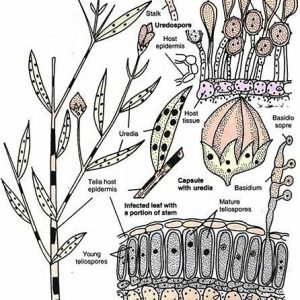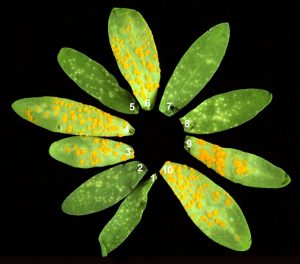Rust of Linseed
- Linseed is an oilseed crop which has a high content of omega-3 fatty acid called alpha-linolenic acid.
- Rust of linseed is a common disease of flax cultivating areas of the world.
- In India flax is a crucial oilseed crop cultivated in nearly all the states. The crop is commonly cultivated in between October- April.
- The disease normally appears in February or later but Butler( 1918) has identified the disease in central India in earlier November.
- At the time of crop obtaining the affected plants get a fired arrival due to the existence of telial sori.
Effects of the Rust of Linseed
- The disease results in a disastrous effect on the plants. Once the disease sets on the field, most of the linseed fields in the area get effected within no time also this disease normally occurs in infectious form.
- Severely infected plants get largely defoliated due to which starch collection is also reduced. Vastly of the food reserves of the host is absorbed by the pathogen resulting in a decrease in the yield of seeds and integrity of fibres.

Symptoms of the rust of Linseed
- The leaves are early to show the symptoms and slowly all the aerial parts of the plant get contaminated or infected.
- Tcontaminatedted parts possess large, orange-yellow coloured uredospustules (uredia, uredosori) which effect very conspicuous appearance to the infected plants in the field.
- The uredia are nearly round and small occurring on both the surface of the leaves but they are extended and irregular on stems. However, the heavily infected leaves start expressing necrosis which later on, the outcome in their premature death.

Management of rust Disease
- In the later stage of infection, reddish-brown teleutopustules (Telia, trliosori) develops on leaves(if the leaves are not removed early as a result of premature death) and most naturally on stems.
- Often, encircled by the reddish-brown Telia are the orange-yellow uredia. Commonly the uredia crack the epidermis and its contents ( uredospores, paraphyses) project out on the host surface but the Telia fail in doing so it’s content still undercover appearing glossy.
- The solely sure estimate for the management of this disease is the use of resistant varieties. In India, the following varieties have been found to be resistant to the disease- NP(RR)9, 10,56, 218, 368, 389, 415, 501.
- Seed therapy to inactivate the teleutospores in hilly areas has been implied.
- Avoid of unreasonable nitrogenous manures, which favour lush growth, is advised.